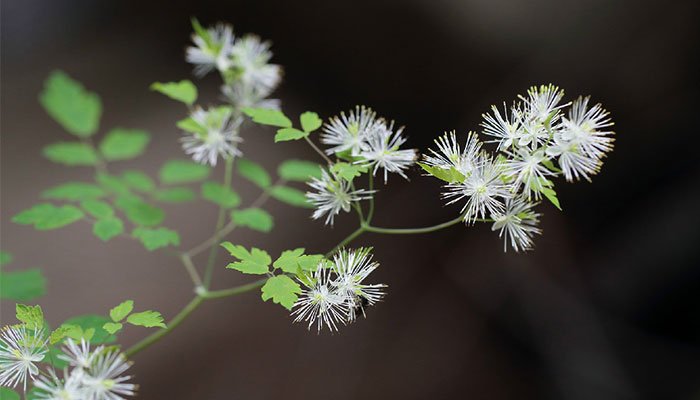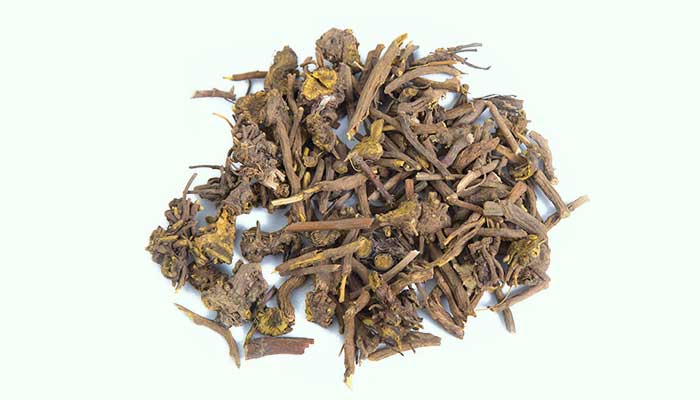What Is Ma Wei Lian
Ma Wei Lian is the root and rhizome of Thalictrum foliolosum, T. baicalense, or T. delavayi, which is a perennial herb belonging to the family Ranunculaceae. It first appeared in <Ben Cao Gang Mu Shi Yi> (a supplement to the compendium of materia medica) in the 30th year of Qianlong in the Qing Dynasty (1,765 AD).
There are about 200 species of Thalictrum, which are distributed in Asia, Europe, Africa, North America, and South America. Among them, there are more than 70 kinds distributed in China.
About 30 kinds of them are often used as folk medicine in China, Pakistan, Japan, Turkey, Russia, and other countries.
Thalictrum foliolosum often grow in mountain forests or grass slopes at an altitude of 1,500-3,200 meters. They are distributed in China, Nepal, and India.

T. baicalense often grow in mountain forests or grass slopes at an altitude of 900-2,800 meters. They can be found in China, North Korea, and the Russian Far East.
T. delavayi often grow in the edge of the mountain forests, shrubs, or sparse forests at an altitude of 2000-3500 meters. They are mainly distributed in Sichuan, Yunnan, and Tibet in China.
In the autumn and winter of each year, people gather the roots and rhizomes of Thalictrum foliolosum, T. baicalense, or T. delavayi, remove their impurities, cut them into segments, dry them in the sun, use them directly, and make them into Chinese herbal medicines.
Ma Wei Lian contains berberine, palmatine, jatrorrhizine, magnoflorine, thalifendine, columbamine, thalidastine, dehydrodiscretamine, dehydrodiscretamine, thalrugosidine, thalrugosaminine, thalirugidine, oxyberberine, berbamine, triterpene saponins, flavonoids, β-sitosterol, β-D-glucopyranose, cardiac glycosides, and Vitamin C.
According to <Ben Cao Gang Mu Shi Yi>, the medicinal nature of Ma Wei Lian is relatively cold, with a bitter taste. It has a certain therapeutic effect on the pathological changes of the heart, lung, liver, gallbladder, and large intestine meridians.
In traditional Chinese medicine, it is often used to clear heat and dry dampness, purge fire and remove toxins, treat enteritis, bacillary dysentery, arthritis, pharyngitis, jaundice hepatitis, gum swelling and pain, measles, dermatitis, skin ulcers, and burns.
In Chinese folk medicine, Ma Wei Lian can be used as a substitute for Huang Lian (Rhizoma coptidis). The reason may be that Ma Wei Lian contains a large amount of berberine, and its efficacy is similar to that of Huang Lian.
Benefits
- Anti-inflammation, alleviate xylene-induced ear swelling in mice.
- Promoting bile secretion and inhibiting gastric juice secretion.
- Berberamine can directly dilate blood vessels and lower blood pressure.
- Inhibiting platelet aggregation induced by adenosine diphosphate and collagen.
- Inhibiting human liver cancer cells HepG2, liver cancer cells BEL7402, colon cancer cells HCT8, and lung cancer cells A549.
- Clearing heat and drying dampness, treating diarrhea and jaundice caused by damp-heat.
- Purging heart fire and alleviating dysphoria caused by febrile diseases.
- Purging lung fire and relieving cough caused by lung heat.
- Clearing liver heat and relieving redness and swelling of the eyes caused by liver heat.
- Removing heat toxins and treating skin ulcers and abscesses.
- A small dose of berberine can excite the heart, enhance the contractility of the heart, and increase coronary blood flow.
- Large doses of berberine can inhibit the heart and weaken the contractility of the heart.
- A small dose of berberine has a strengthening effect on the excitatory process of the cerebral cortex of animals, and a large dose of berberine has a strengthening effect on the inhibitory process of the cerebral cortex.
- Clinical studies have confirmed that berbamine can treat leukopenia caused by radiotherapy, chemotherapy, or drugs.
- Its decoction can inhibit diphtheria, Staphylococcus aureus, Proteus, Shigella flexneri, Escherichia coli, Salmonella, pneumococcus, and Candida albicans.
- Studies have found that its total alkaloids have a good effect on the early treatment of silicosis rats.
Combinations
- It can be used in combination with Wu Zhu Yu (Evodiae Fructus), etc. to relieve vomiting caused by damp-heat or stomach cancer.
- It can be used in combination with Huang Qin (Radix Scutellariae), Ge Gen (Kudzu Root), Bai Tou Weng (Radix Pulsatillae), etc. to treat diarrhea caused by damp-heat.
- It can be used in combination with Yin Chen (Herba Artemisiae Scopariae), Zhi Zi (Fructus Gardeniae), Huang Bai (Cortex Phellodendri), etc. to treat jaundice caused by damp-heat.
- It can be used in combination with Zhi Zi (Fructus Gardeniae), Dan Zhu Ye (Lophatherum Gracile), etc. to alleviate irritability caused by febrile diseases.
- It can be used in combination with Huang Qin (Radix Scutellariae), Sang Bai Pi (Cortex Mori), Di Gu Pi (Cortex Lycii), etc. to relieve cough caused by lung heat.
- It can be used in combination with Pu Gong Ying (Dandelion), Ju Hua (Flos Chrysanthemi), etc. to alleviate carbuncle and skin ulcers.
Side Effects
At present, there is no literature report that Ma Wei Lian has toxic effects, and there is no data showing that taking it at the prescribed dose can cause serious adverse reactions.
Precautions and Warnings
- The dosage of Ma Wei Lian should be controlled at 6-12g.
- It can be made into decoctions or ground into powder for external use.
- People who are allergic to Ma Wei Lian should not take it.
- Patients with deficiency-cold in the spleen and stomach should not take it.
- Pregnant women should not take it.
